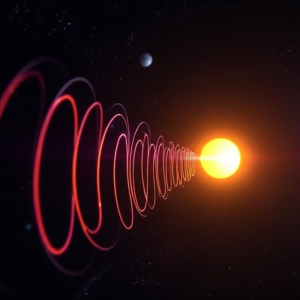What are Electromagnetic Waves?
Electromagnetic (EM) waves are waves that carry energy through space. Unlike sound waves, which need a material (like air or water) to travel through, electromagnetic waves can travel through empty space (a vacuum). This is why we can receive light from the Sun even though space itself is empty!
These waves are made up of electric fields and magnetic fields that are perpendicular (at right angles) to each other and to the direction in which the wave is traveling. The best way to think about EM waves is like a combination of electric and magnetic energy traveling together through space.

How do Electromagnetic Waves Propagate?
“Propagation” simply means how these waves spread or travel from one place to another. For electromagnetic waves, propagation happens in the following way:
- Oscillating Electric and Magnetic Fields:
- Electromagnetic waves are created when an electric charge (like an electron) accelerates, meaning it moves or changes its speed. This creates changing electric and magnetic fields.
- These oscillating electric and magnetic fields move or propagate outward from the source at the speed of light (which is about 300,000 kilometers per second in a vacuum).
- Perpendicular Nature:
- The electric field oscillates in one direction (say, up and down), and the magnetic field oscillates in a direction that is perpendicular to the electric field (side to side).
- These two fields move together in the same direction, which is the direction the wave is traveling.
- Speed of Light:
- In a vacuum, electromagnetic waves travel at the speed of light. In different materials, they may travel slower (like light passing through water or glass).
Types of Electromagnetic Waves
Electromagnetic waves can have many different wavelengths (the distance between two peaks of the wave). Based on the wavelength and frequency, EM waves are divided into different types, forming the electromagnetic spectrum. Here’s a quick look at some common types of EM waves:
- Radio Waves: These have the longest wavelengths and are used for communication, like AM/FM radio, TV signals, and cell phones.
- Microwaves: These are used in microwave ovens and for satellite communication. They have shorter wavelengths than radio waves.
- Infrared (IR) Waves: These are the heat waves we feel from the Sun and other warm objects. Night-vision cameras also use infrared waves.
- Visible Light: This is the tiny part of the EM spectrum that we can see with our eyes. Different wavelengths correspond to different colors, from red (longer wavelength) to violet (shorter wavelength).
- Ultraviolet (UV) Waves: These waves have higher energy than visible light and can cause sunburns. They’re also used for sterilizing equipment.
- X-rays: These waves have even higher energy and are used in medical imaging to see inside the body.
- Gamma Rays: These have the shortest wavelengths and the highest energy. They’re produced by nuclear reactions and can be dangerous in large doses, but they are also used to treat cancer.
Key Features of Electromagnetic Wave Propagation
- Travel Through Vacuum: Electromagnetic waves can travel through vacuum (empty space), unlike sound waves, which need a medium (like air or water). This is how sunlight travels through space to reach Earth!
- Speed: All electromagnetic waves travel at the same speed in a vacuum – the speed of light. This speed is approximately 300,000 kilometers per second.
- No Medium Required: Unlike sound or water waves, EM waves do not need any medium to travel. They can move through empty space, which is why radio signals can reach us from satellites or distant planets.
- Wave Behavior: Electromagnetic waves behave like other types of waves. They can:
- Reflect: Bounce off surfaces, like light reflecting off a mirror.
- Refract: Bend as they pass from one medium to another, like when light bends in water.
- Diffract: Spread out when they pass through small openings or around obstacles, like sound waves do.
- Energy Transfer: The energy carried by electromagnetic waves can be absorbed by materials (like how your skin absorbs sunlight and turns into heat). This energy transfer is one way that electromagnetic waves interact with matter.
Summary of How Electromagnetic Waves Propagate:
- Electric and magnetic fields oscillate and create a wave that moves through space.
- These waves travel at the speed of light and don’t need a medium.
- They can travel through vacuum (empty space), which is why sunlight can reach Earth.
- Different types of electromagnetic waves have different wavelengths and frequencies, creating the electromagnetic spectrum.
- Electromagnetic waves are responsible for many everyday technologies, like radio, TV, microwaves, and light.
In Simple Terms:
Electromagnetic waves are like invisible ripples of energy moving through space, created by electric and magnetic forces. They can travel through empty space, and they include things like light, radio waves, and X-rays











